With user signals, brand awareness, and algorithm shifts all changing the game, we asked a simple question:
Can on-page SEO alone still move the needle?
Inspired by Ahrefs’ backlink study, we ran our own. This time, focused on content and on-page factors.
We analyzed 1 million search results, cleaned the data with keyword clustering, and looked at what correlates with high rankings today.
And if you're wondering why we're talking about good old-fashioned SEO while everyone’s buzzing about AI search, LLMs, and all that—here’s the thing (and it’s probably not news to you):
AI overviews and LLMs pull their answers from top-ranking pages.
So if you want to be visible everywhere people search, ranking high on the SERPs is still the game to win.
Methodology
We analyzed 1 million unique search queries and pulled the top 20 organic results for each, similar to how Ahrefs tested backlink signals.
To avoid SERP duplication (like 100 variations of “how to cure a headache” returning the same pages), we used Surfer’s Topical Map to cluster similar queries and selected one keyword per cluster.
We used Spearman’s rank correlation to measure the relationship between each on-page factor and ranking position. Spearman values range from -1 to 1.
Spearman correlation doesn’t measure causation, but it does show how consistently two things move together. A perfect correlation would be 1.0; a score of 0 means no relationship at all.
And yes, we also tested smaller samples. 10K or 100K gave almost identical results. But 1 million? Looks better in the headline.
1. Topical coverage is the new SEO superpower
If there’s one signal that stood out across the entire 1 million SERP study, it’s topical coverage.
Topical coverage has become the most important on-page factor for ranking in 2025.
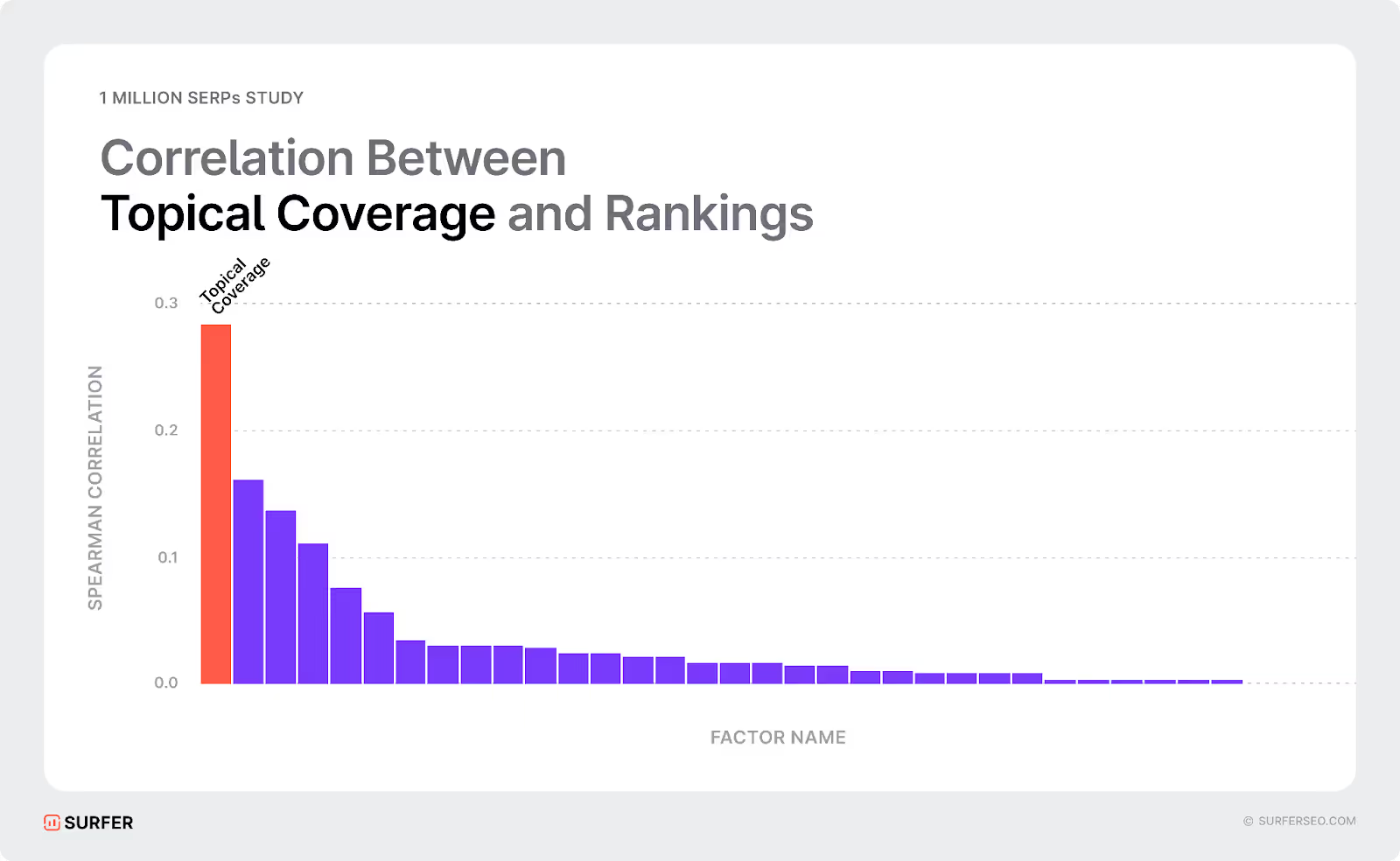
We defined topical coverage not just by keyword presence, but by the depth and breadth of related entities, facts, and subtopics included in a page. It's about how well a piece of content educates, guides, and informs the reader across a topic.
Take an article on “beard grooming tips.” Mentioning keywords like “beard conditioner,” “beard hair,” and “split ends” in isolation does little to establish relevance.
But connect them in a sentence like “Use a beard conditioner to soften beard hair and reduce split ends,” and the value becomes clear.
That’s exactly the kind of insight Surfer’s Coverage Booster is built to surface.
It scans top-performing SERPs, AI Overviews, and trusted language models (LLMs) like ChatGPT and Perplexity to identify context-rich facts, subtopics, and relationships your content might be missing.
It can also insert them directly into your content. So instead of manually digging for ways to improve coverage, you get ready-to-use, high-context additions that strengthen your article in seconds.
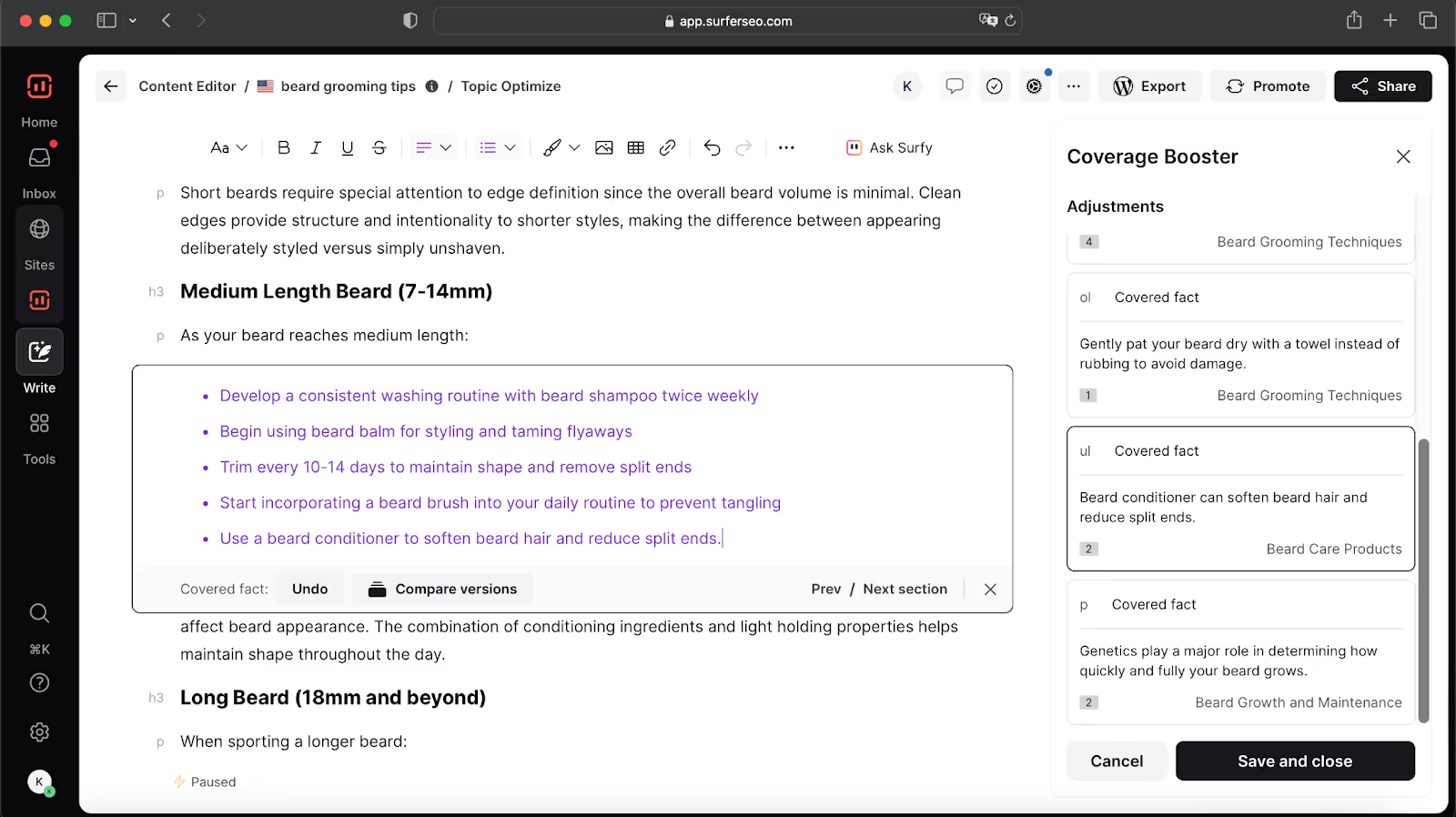
Incorporating these factual links helps improve topical coverage, which is one of the strongest on-page signals tied to better rankings.
We also saw this first-hand in our internal case study of Surfer’s blog:
- The top 10 performing pages covered ~74% of the relevant facts and subtopics surfaced from competitor analysis.
- The bottom 10 averaged only ~50%.
The benefit isn’t just better rankings for a single keyword. It’s breadth.
Pages with high topical coverage tend to rank for hundreds of long-tail terms, naturally absorb variations, and earn more traffic over time without needing separate posts for every phrase.
2. Keyword variations beat exact matches
We analyzed heading structures, paragraph content, and keyword placements. The standout insight?
Pages that used keyword variations — not exact matches — throughout the page performed best.
Keyword variations are different ways of saying the same thing. For example, instead of just using “best running shoes,” you can say “top sneakers,” “jogging shoes,” or “athletic footwear.”
It’s the difference between writing for meaning vs. just matching a phrase word-for-word.
We’ve known this for some time. That’s why we’ve updated Surfer’s Content Score to reflect how search engines evaluate content.
Specifically, from our analysis, we found that pages using variations in H2s, H3s, and H4s consistently outperformed those that repeated the same keyword across every heading.
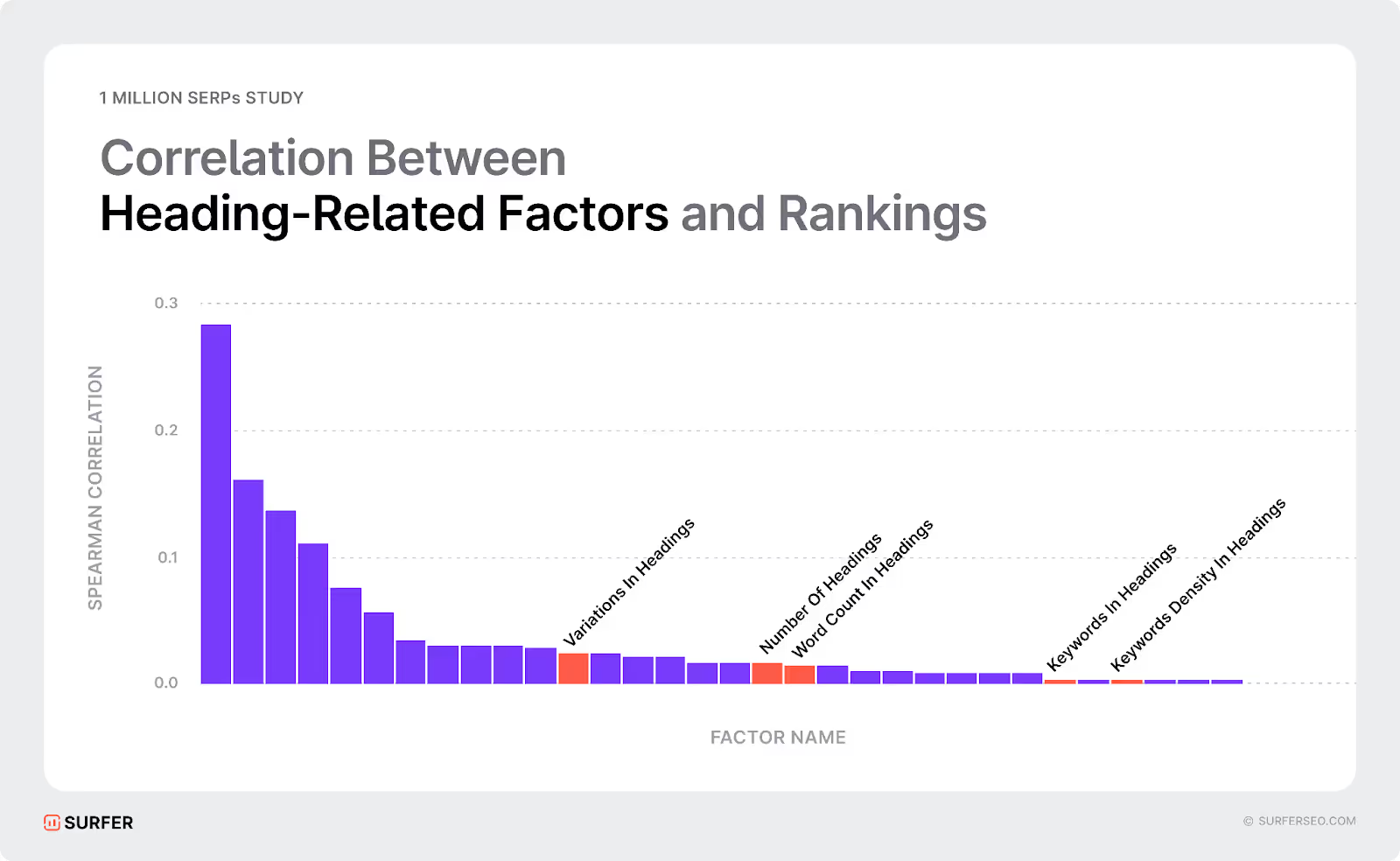
We also see that factors like “Word Count in Headings”, “Keywords in Headings”, and “Keyword Density in Headings” all show low correlation with rankings.
In other words, longer, keyword-stuffed headings don’t seem to help. Concise, purposeful, and varied headings are likely a better bet.
This reflects a broader trend: Google understands synonyms and expects semantic diversity. Repeating the same keyword across all headings no longer improves relevance; it limits it.
We also saw this pattern clearly in the body content. The number of keyword variations used in paragraphs had a much stronger correlation than exact-match terms.
It’s no longer about how many times you repeat a phrase. It’s about how well you express the concept in different, natural ways.

That shift reflects how search has changed: more nuance, more angles, more coverage.
Let’s say you’re writing an article on “what is catnip.” Instead of repeating that exact phrase in every heading or paragraph, top-performing pages naturally work in variations like “catnip plant” and “Nepeta cataria.”
They also add contextual terms like “scratching post,” “catnip sprays,” and “too much catnip” to expand topical depth and relevance.
That’s exactly the kind of variation Surfer’s Content Editor helps you uncover and use. You don’t have to guess what to include, you can see the variations directly inside the Content Editor.
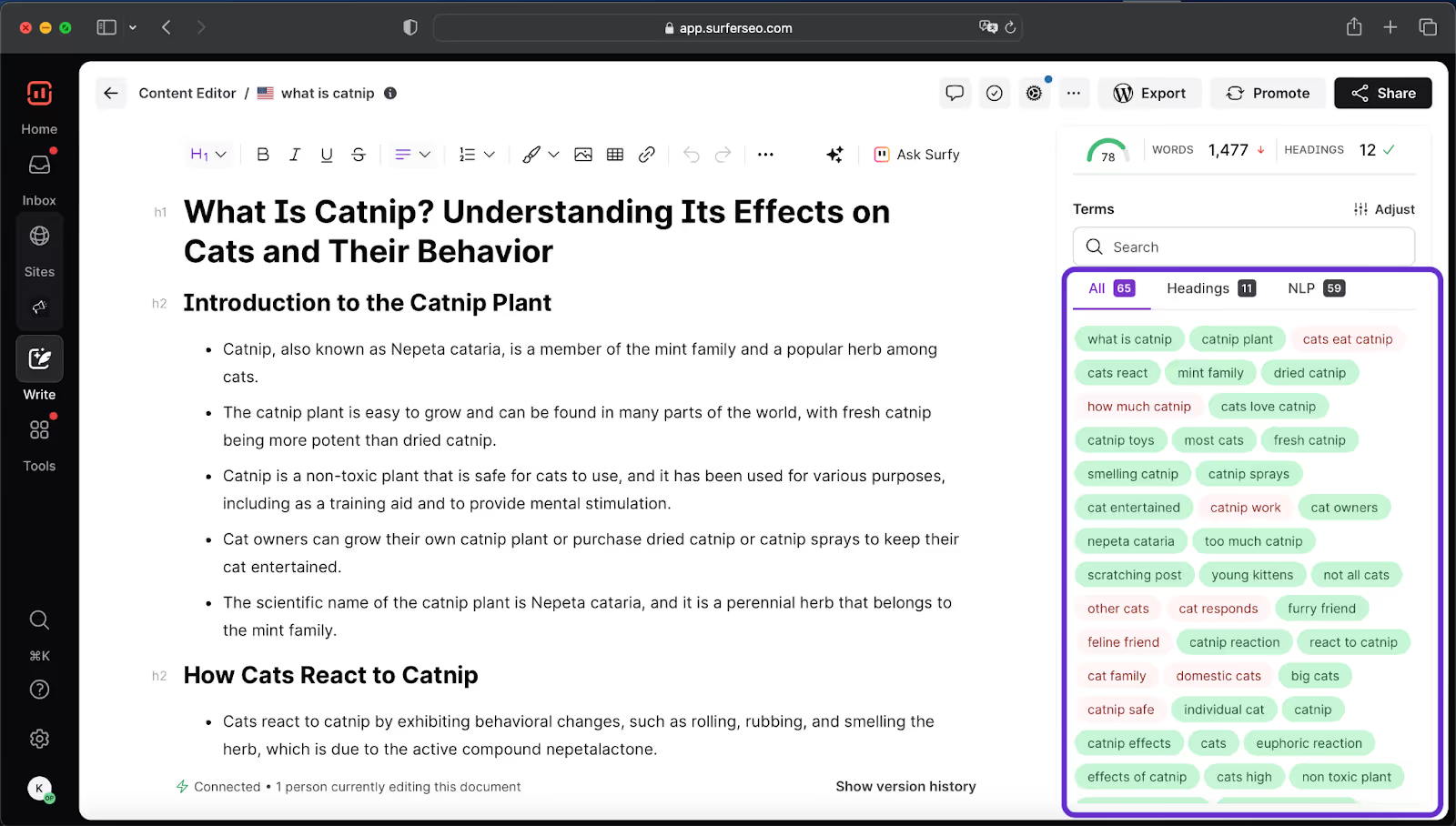
Together, these variations signal that the content doesn’t just mention catnip, it explains what it is, how it works, and why it matters.
This makes it easier to go beyond exact-match keywords and build content that covers the full scope of the topic.
Bottom line: Structure your heading and subheadings around different aspects of the topic. Use cases, supporting questions, and adjacent concepts. Then, use your body text to introduce variation naturally.
If you’re looking to automate this part of the process, the Insert Outline feature inside the Content Editor has you covered. It generates a ready-to-use article outline with:
- Keyword variations naturally placed in headings and subheadings
- Detailed bullet points for the body content
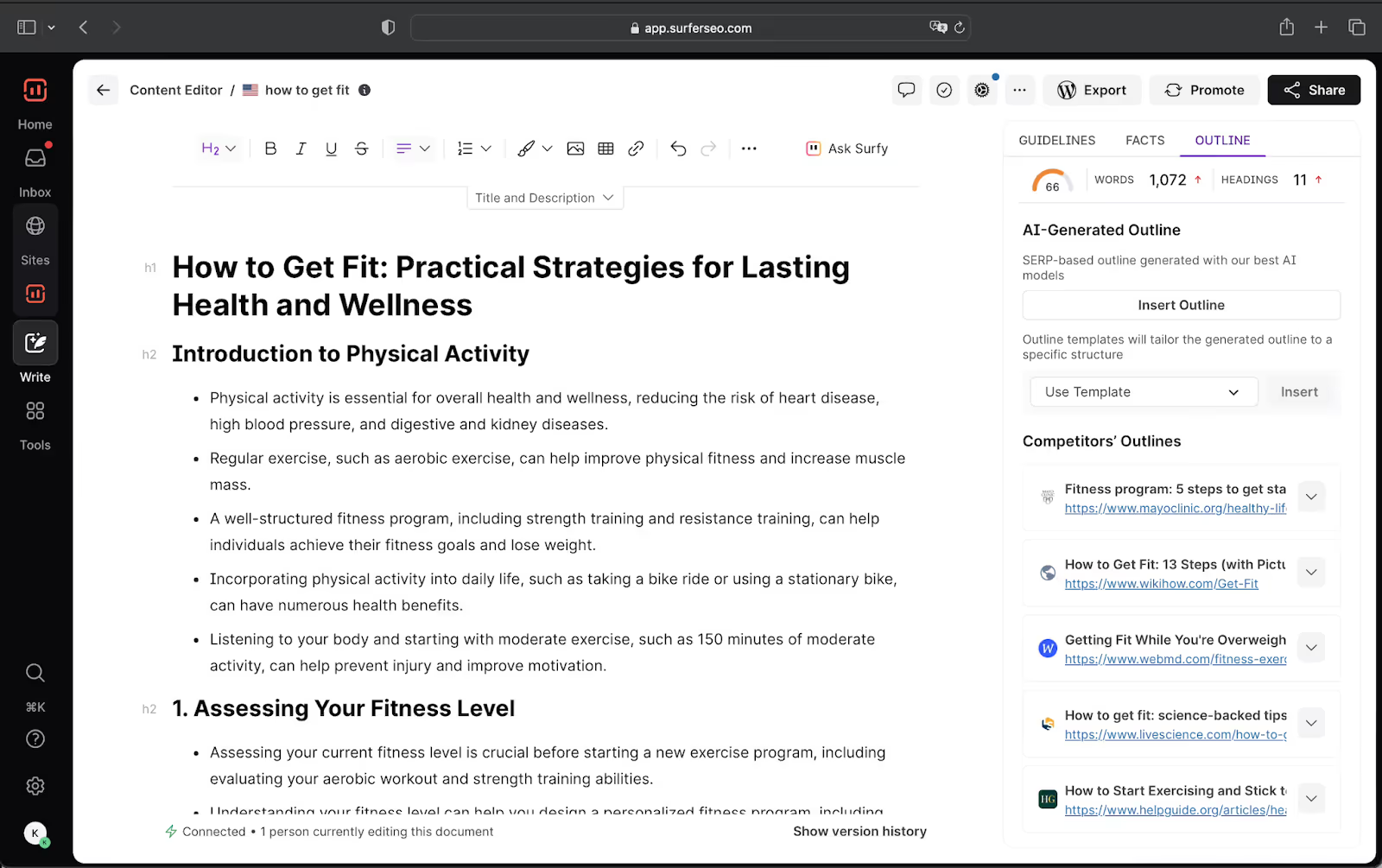
It doubles as an article brief, making it super easy for writers to stay aligned with SEO best practices from the start.
3. Keyword density is dead
Once a sacred metric, keyword density now does zero work in helping pages rank.
In our analysis, exact-match keyword usage showed almost no correlation.
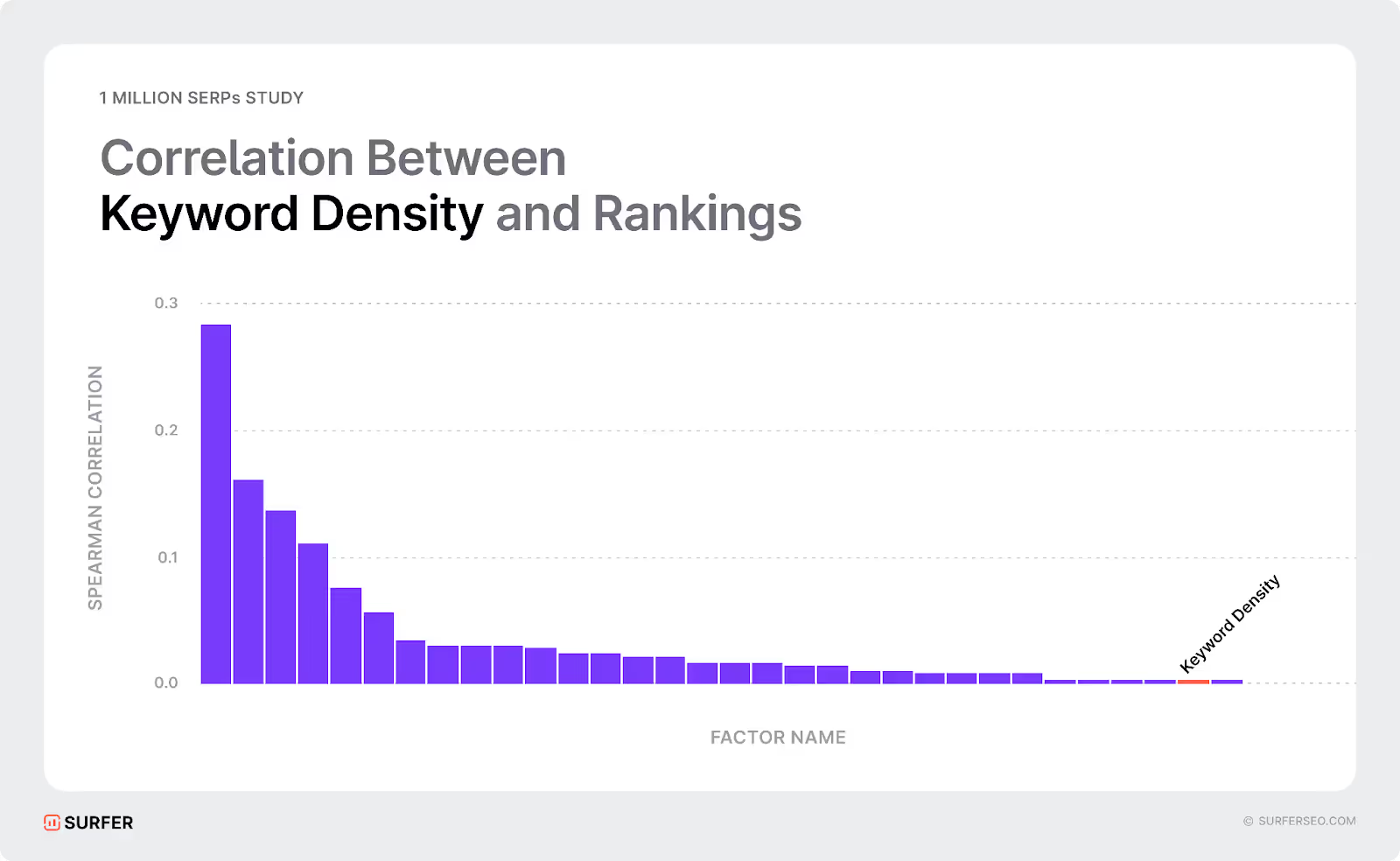
Pages that ranked at the top weren’t repeating exact-match keywords more often. In fact, keyword-stuffed content was just as likely to rank poorly.
Density has been fading for years. This study confirms it’s now irrelevant.
So if you’re still asking “how many times should I use my keyword in this paragraph,” you’re asking the wrong question.
Google doesn’t care. Use it once. Use it ten times. It won’t help unless the page itself is useful.
The takeaway?
Stop counting keywords. Start covering the topic.
And if you’re wondering why Surfer’s Content Editor counts keyword density, let me tell you that we don’t. Keyword density is not part of Surfer’s content scoring. In fact, it never was.
Nowadays, you’ll see that keyword ranges are turned off by default. You can choose to turn them on, but they’re meant to be used as directional guides, not hard limits.
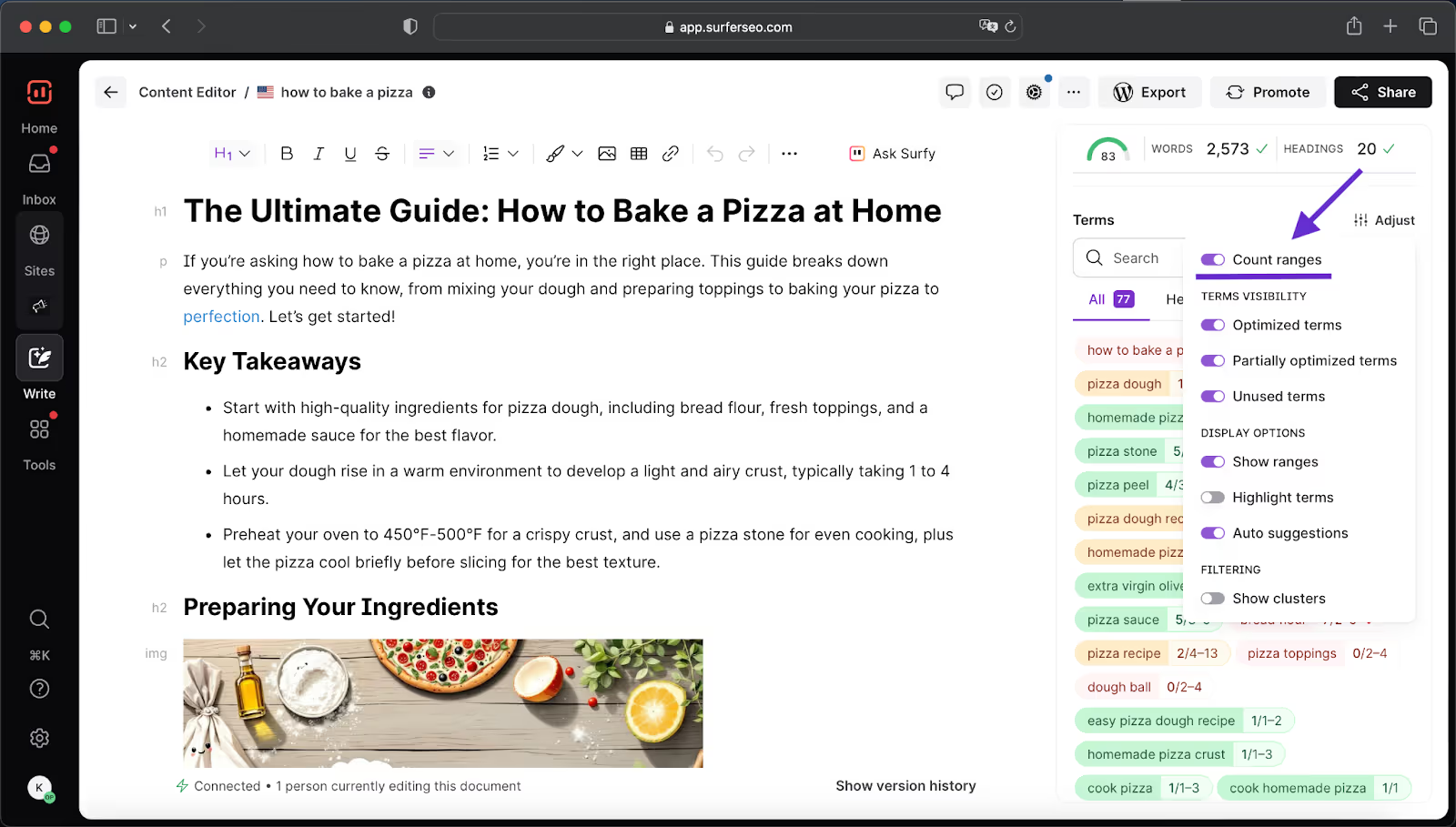
Those keyword suggestions aren’t there to be gamed. They’re there to show which terms are topically important, based on what consistently shows up in top-ranking content.
Pro tip: It’s better to use more variations at least once rather than to repeat the exact same keyword the same number of times as your competitors.
4. Bolded keywords work (and cost nothing)
We didn’t expect bolded text to show up in the results, but it did. And it correlated more strongly than expected.
Pages that bolded keywords or keyword variations in their body copy performed slightly better than those that didn’t. It’s not a huge lift, but the signal is there.
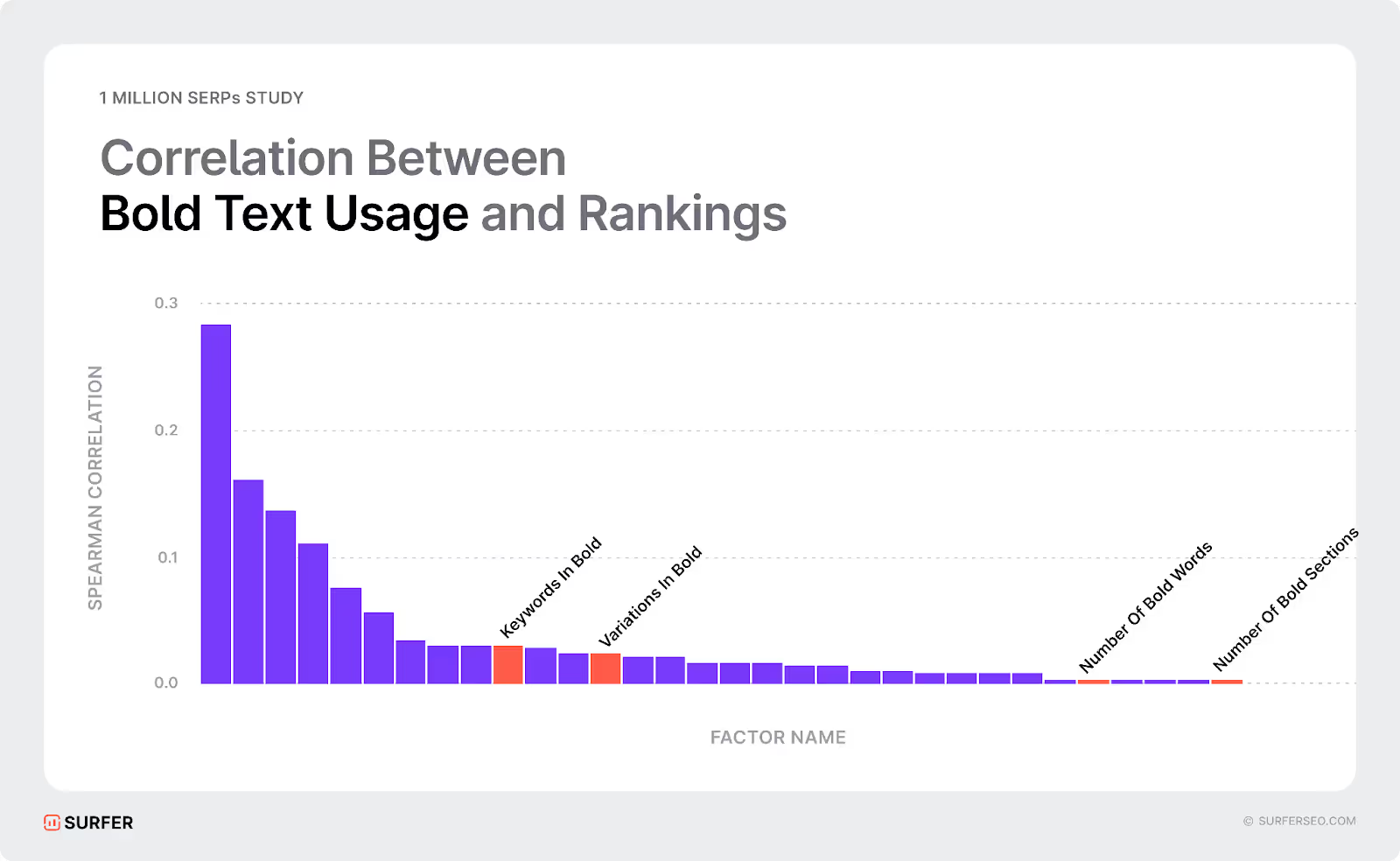
Highlighting important terms makes them more noticeable to both users and search engines.
This isn’t about bolding every instance of a keyword. That looks unnatural and doesn’t help. But when you use bold to emphasize key phrases, especially in longer content, it helps guide the reader and reinforces topical focus.
And from a content creation standpoint, it’s an easy win. No extra words. No extra tools. Just better formatting.
If you’re already covering the topic well, emphasizing the right phrases can give your content a small but meaningful edge.
As Surfer’s Michal Suski puts it: “Bold is gold. Costs zero. Why not?”
5. Long content isn’t the goal, it’s the outcome
Word count doesn’t rank content. Coverage does. (You’re starting to notice the pattern?)
Our study found only a weak correlation between raw word count and higher rankings.
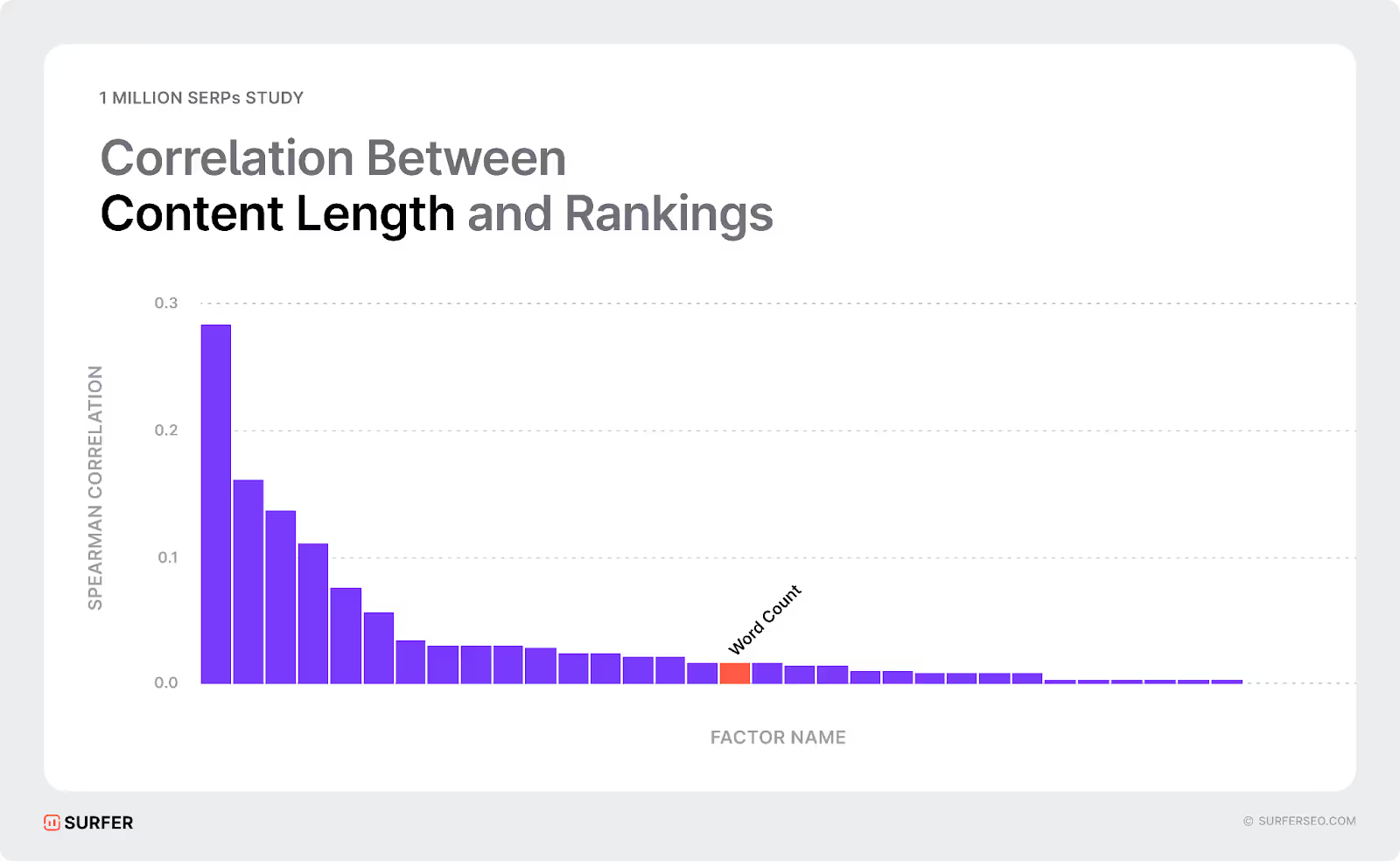
In isolation, length doesn’t predict success. But the best-performing pages often are longer, and for good reason: they have more to say because they cover more ground.
They anticipate reader questions and offer layered, complete explanations. In this context, length is simply a byproduct of doing the job well.
A 500-word blog post can technically rank, but it’s unlikely to outperform a 1,500-word piece that answers the question fully and supports it with helpful detail.
Surfer’s Content Editor helps you get that balance right. It provides content length and structural guidance based on what works for your topic, so you can create content that is as long as it needs to be, no more and no less, to compete.
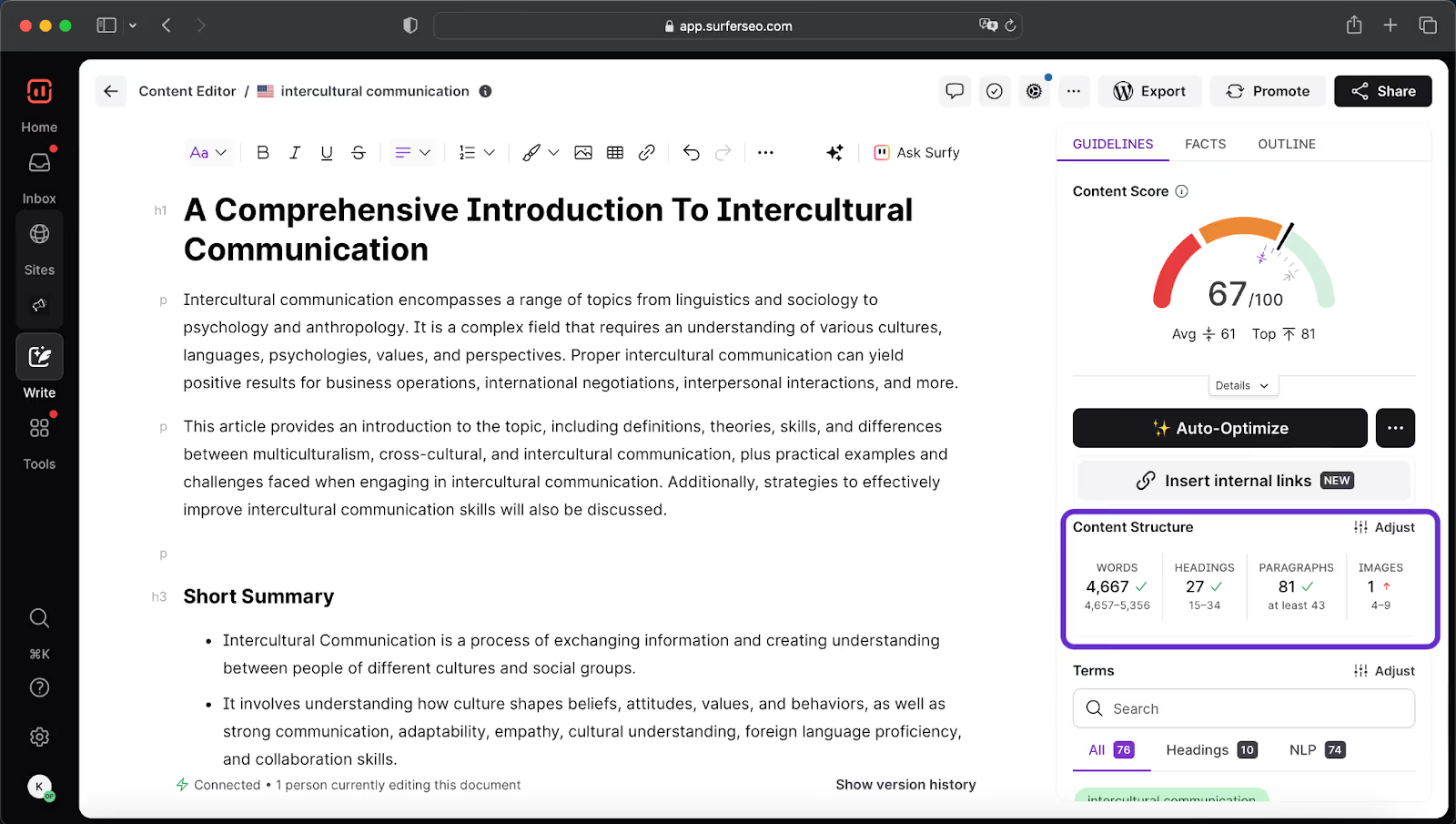
Don’t confuse “long” with “better.”
Search engines, especially those powered by LLMs, are increasingly tuned to information density, not just word count. They don’t reward sidetracks, filler, or storytelling for its own sake. They prioritize clear, relevant, high-signal content that delivers answers quickly and confidently.
Focus on structure and completeness. Your content should feel finished, not just long.
6. Exact match domains still matter. Keywords in URLs don’t.
We didn’t expect this one, but exact match domains (EMDs) still correlate like crazy.
Domains that include the main keyword, either fully or partially, performed significantly better in our dataset.
We’re talking about old-school EMDs, the kind of domains SEOs used to chase a decade ago. Turns out, they’re not dead. In fact, they’re working better than expected.
On the flip side, keywords in the URL path had almost no correlation. And that makes sense.
Everyone has clean URLs now. Most slugs include the title. It’s standard practice, which means it no longer acts as a differentiator in the data.
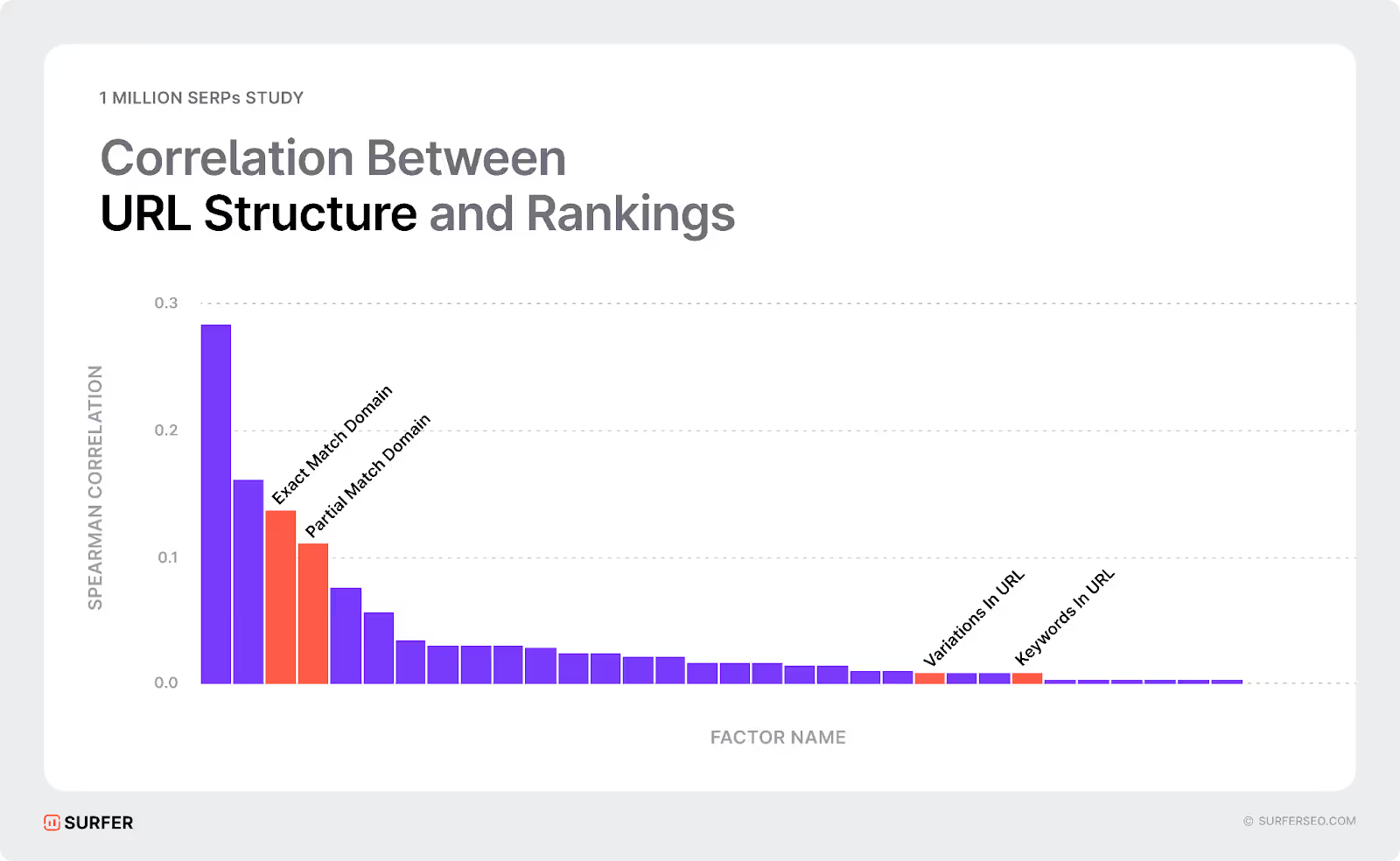
So yes, “bestdogtoys.com” might still help. But “brand.com/best-dog-toys”? That’s just table stakes.
That doesn’t mean you should stop using clear, descriptive slugs. They still matter for rankings, indexing, and user experience. But if you're retrofitting URLs to squeeze in more keywords, save yourself the effort. Google’s not looking there anymore.
And if you're launching a new site and can get the EMD, go for it. It's one of the few shortcuts that seems to work.
7. Speed is a strong user signal
Our study found that time to first byte (TTFB) and page load time remain foundational ranking factors, with growing correlation over time.
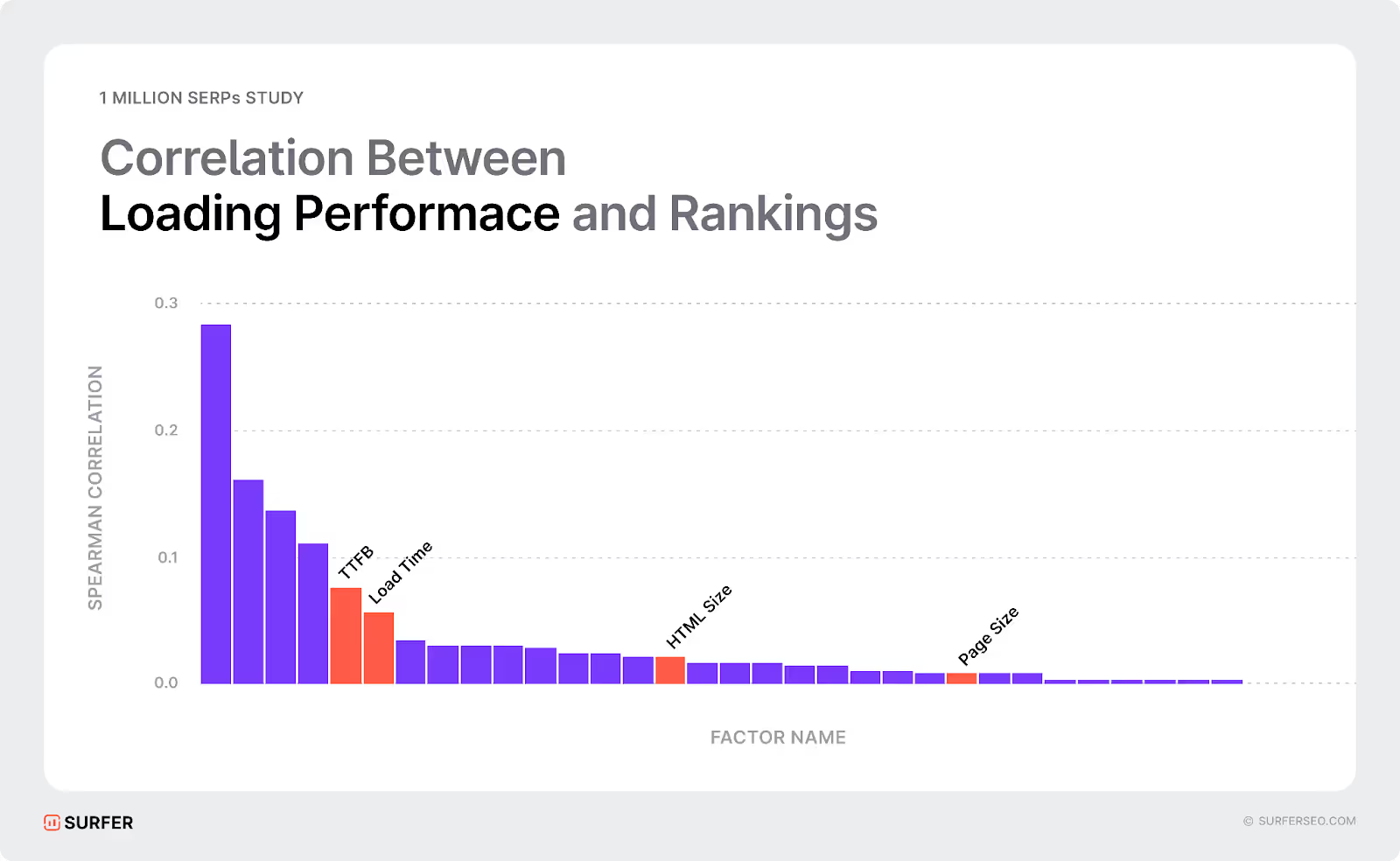
Simply put, fast-loading pages consistently rank higher. But it’s not the load time itself that drives rankings, it’s what speed enables.
Fast pages reduce bounce, increase engagement, and generate stronger behavioral signals. And in 2025, those signals carry more weight than ever.
Google no longer ranks pages purely on what they say. It ranks based on how users respond.
If your site is slow, users leave. If they leave, you don’t rank.
This isn’t a technical bonus. It’s a foundational issue. If your content is great but your load time sucks, you’re leaking performance.
8. Schema helps, but overdoing it hurts
Structured data helps, until it doesn’t.
Another surprising finding in the study was that too many schema types on a single page correlated negatively with rankings.
Pages that tried to cram in every possible markup, article, FAQ, how-to, review, breadcrumb, event, performed worse than those that kept it focused.
The pages that ranked best didn’t skip schema altogether. They just used the right ones.
A single, relevant type, like Article, FAQ, or Product, was often enough.
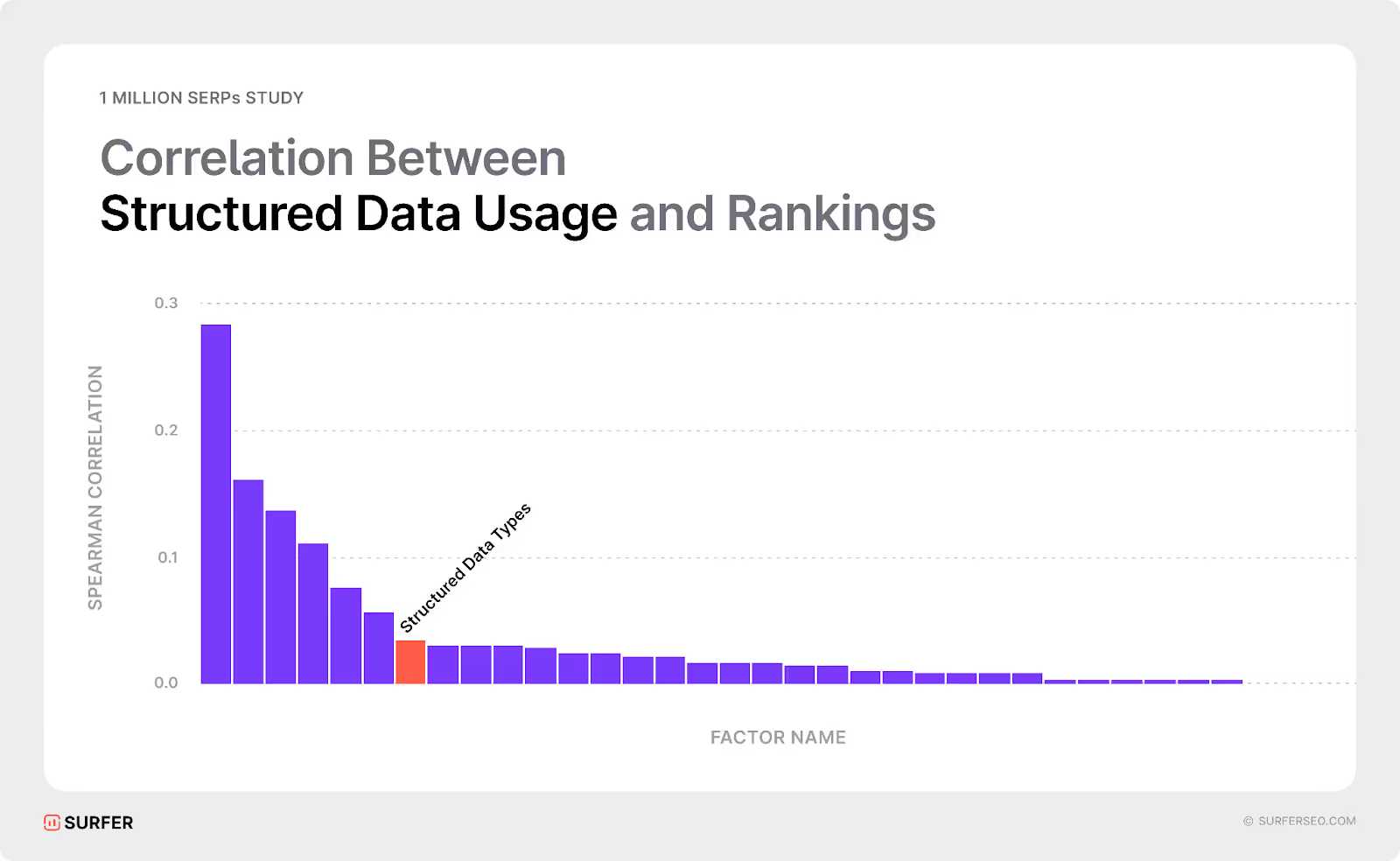
More isn’t better. It’s noise.
Schema should clarify what your page is about, not clutter it. If you’re adding markup that serves no purpose or tries to signal five things at once, you’re doing too much.
Keep it simple. Use schema to support the content, not to impress the validator.
9. AI content is not a ranking signal. Execution is.
While not part of the 1 million SERP dataset, we also ran a separate check using our 10k × top 100 SERPs sample to see how AI-written content performs in today’s rankings.
This dataset gives us a fuller picture of AI content’s predictive power in ranking performance.
Around 50% of the pages we analyzed showed signs of AI-generated content.
The outcome? Nothing. No lift, no penalty. A perfect zero correlation between AI use and rankings.
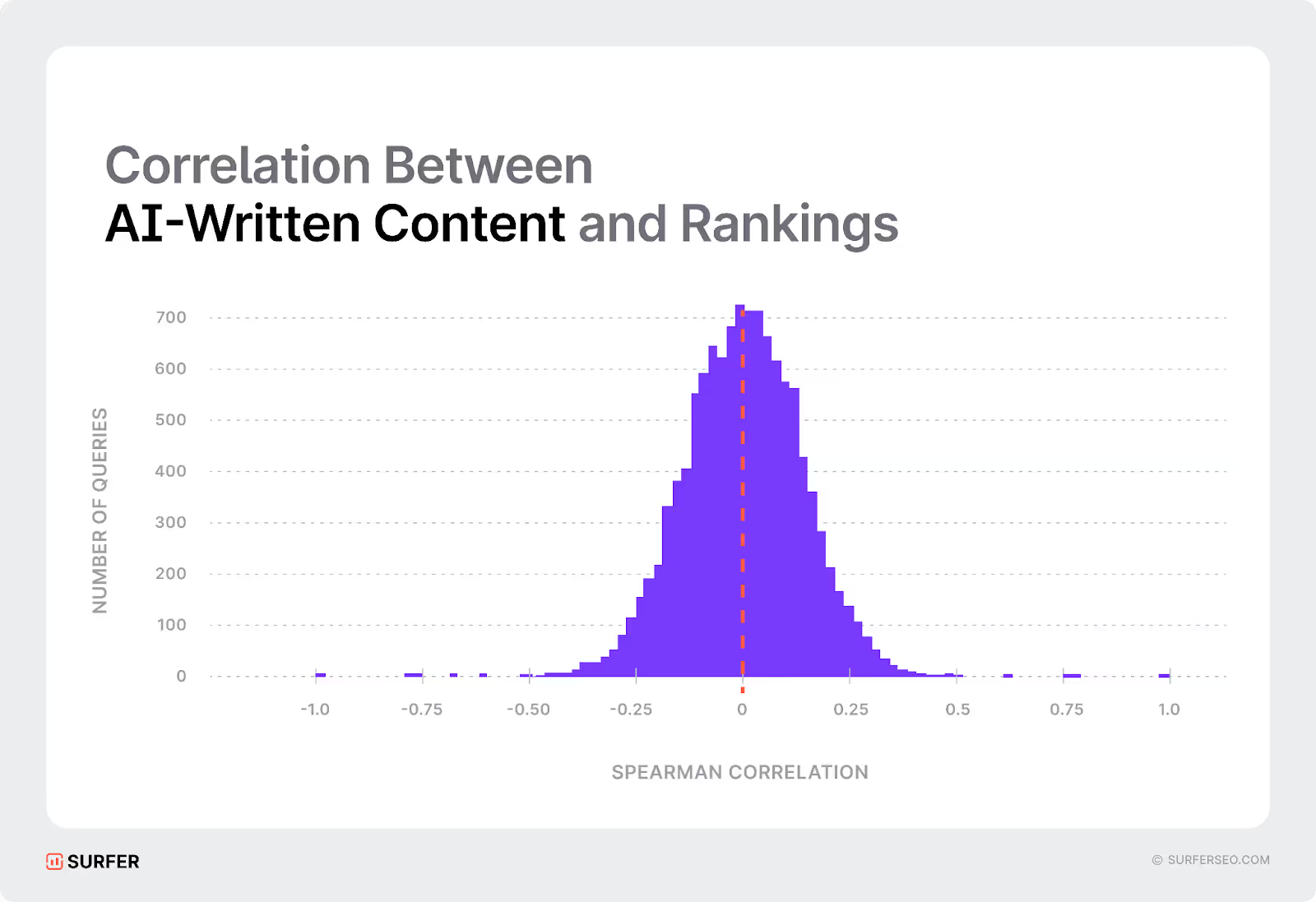
It didn’t matter whether the content was written by a human, an AI, or a combination of both.
We found that pages showing signs of AI content appear just as often at the top of the SERP as they do at the bottom. In other words, Google isn’t penalizing AI-generated content. What matters is how well the content satisfies the user’s intent.
In fact, 75% of B2B marketers are already using AI tools, primarily for content creation. And 70% say it’s made their work more efficient.
With Surfer AI, for example, you can go from idea to a fully optimized article draft in under 3 minutes. It handles research, structure, and content generation in one seamless workflow.
Your article comes ready to publish—fully formatted, in your tone, with safe, high-quality images placed where they work best.
From there, Surfy, our AI assistant, helps you polish it fast with quick edits and researching extra data or facts suggested by Coverage Booster.
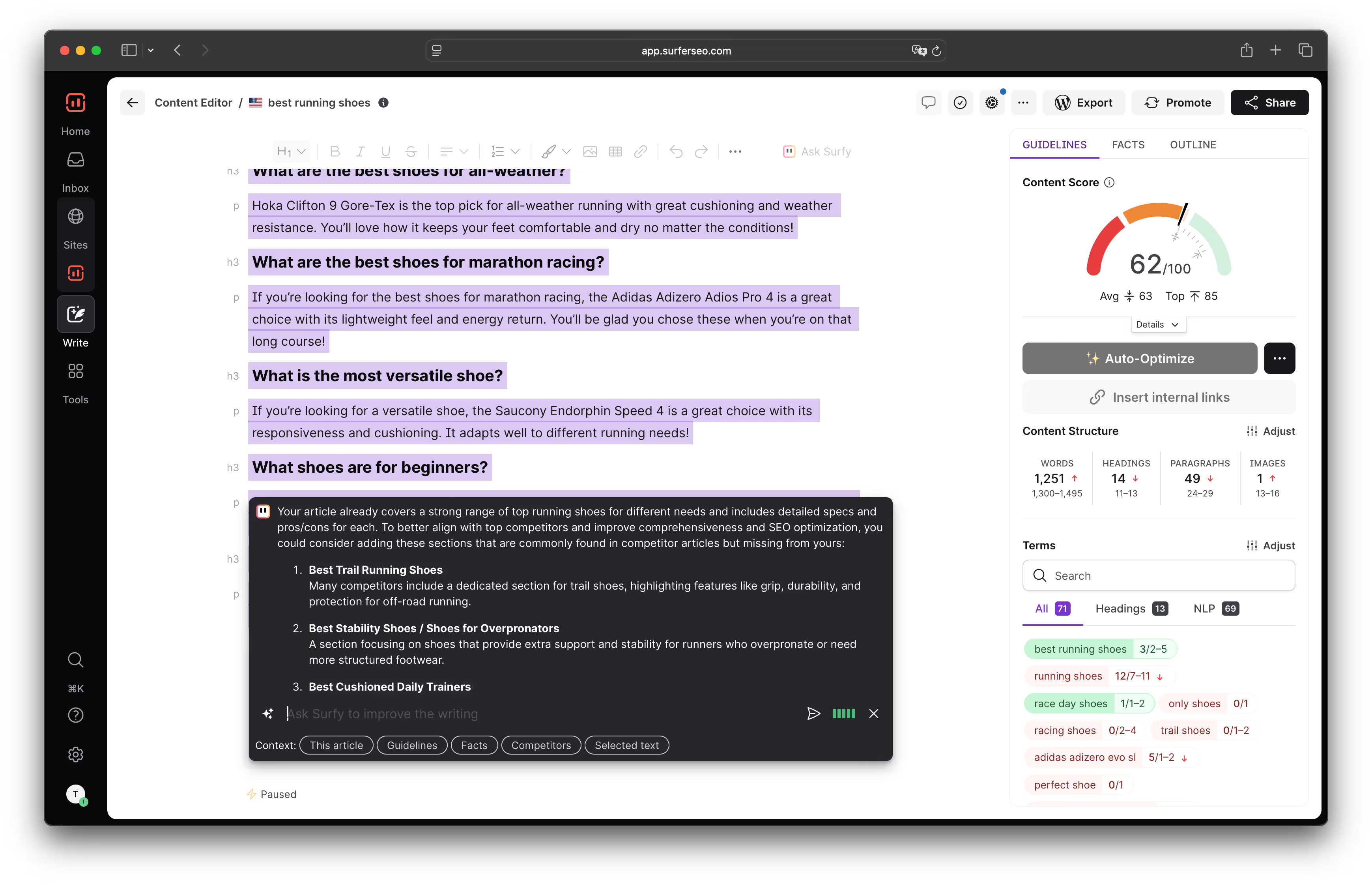
Once your content is optimized, you can take it even further by backing it up with original insights, case studies, or proprietary data.
That’s the kind of substance that not only earns rankings but builds trust.
How Surfer's Content Score reflects these ranking factors
If you’re wondering how to act on this data, that’s exactly what Surfer’s Content Score is built for.
It’s not just a number—it’s a real-time reflection of the on-page factors that actually move rankings. In fact, in our 1-million-SERP-entry study, Content Score showed a 0.28 correlation with rankings, making it one of the strongest controllable signals we tested.
Here’s how it incorporates the winning factors:
- Topical coverage? Baked into Coverage Booster, which helps you close content gaps by suggesting relevant facts, entities, and subtopics you might be missing.
- Keyword variation and semantic depth? Tracked directly in the Content Editor, so you can naturally include the terms and phrases that search engines associate with comprehensive answers.
- Formatting and structure signals? They're part of your workflow, not an afterthought.
In other words, Content Score consolidates the factors that correlate with rankings and gives you a clear way to act on them, whether you’re creating new content or updating what you’ve already published.
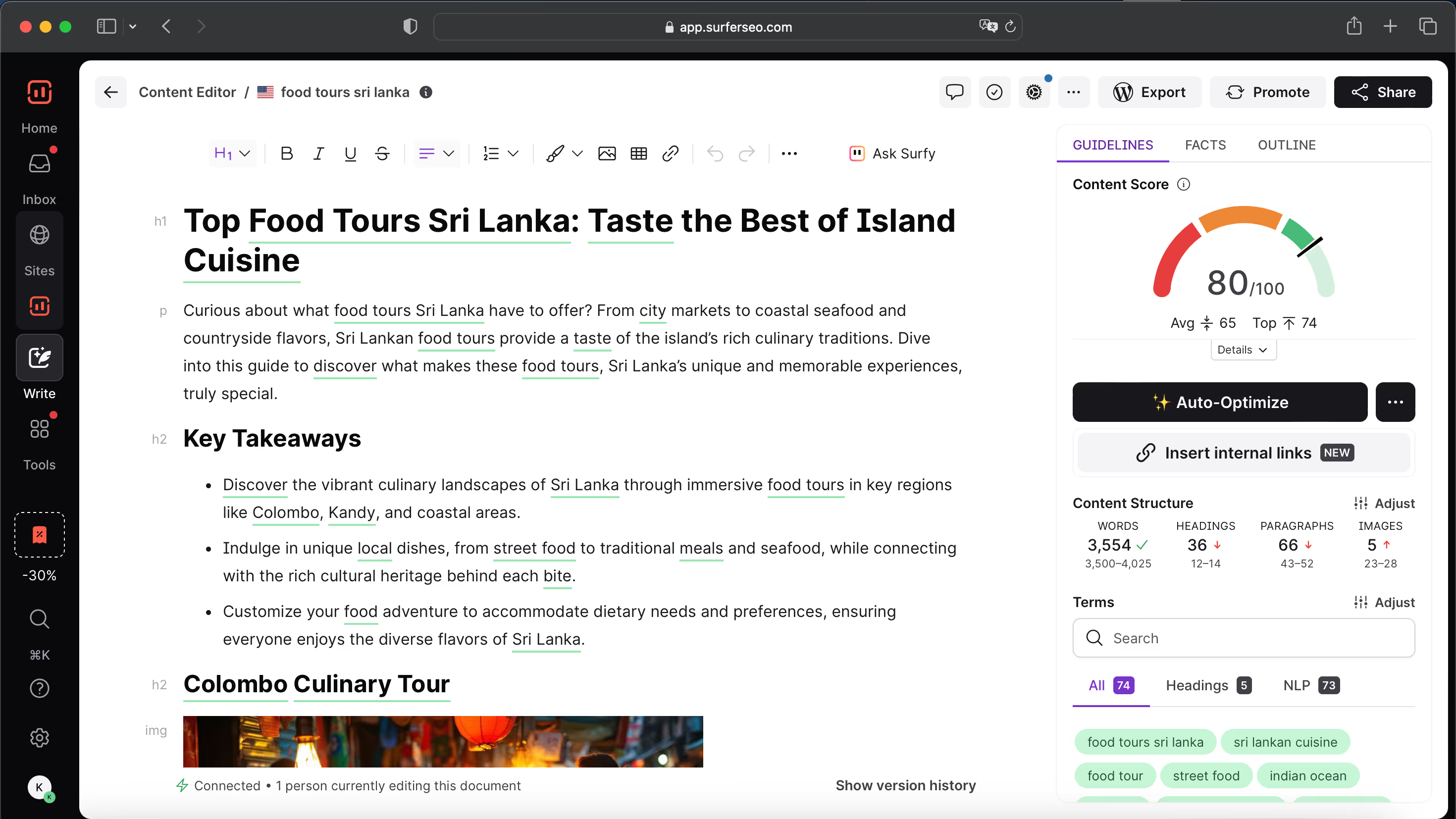
Final thoughts
The data speaks for itself: If your content helps users, answers questions contextually, and reflects deep topical understanding, Google notices, and LLMs do too.
That’s why we’re evolving how Surfer works.
We’ve left behind outdated keyword formulas that focus on how many times a word shows up. We went from exact match to entity coverage and now to contextual understanding. Because that’s where rankings are headed.
The goal is to help you create content that actually deserves to rank, everywhere people are searching.
Surfer is becoming more than a tool. It’s your answer engine for content optimization.
Try Surfer, and see how far your content can go when you optimize for what really matters.
.avif)


